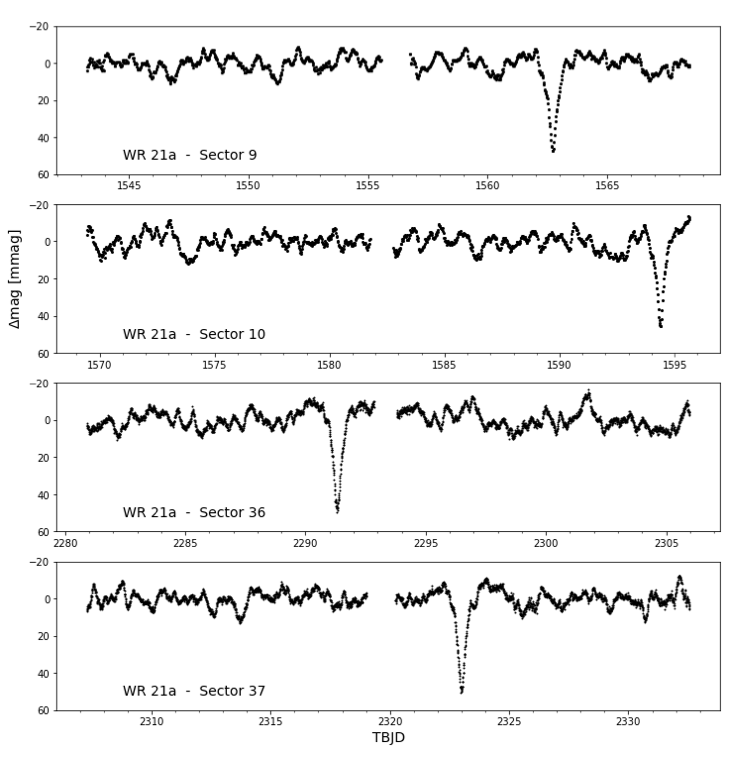STATUS UPDATE: Orbits 1 and 2 of Sector 42 are now available to download as a TICA products from MAST
Welcome TESS followers! This week we are looking at three papers from the archive,
First results on RR Lyrae stars with the TESS space telescope: untangling the connections between mode content, colors and distances (Molnár et. al., 2021) :
An RR Lyrae are horizontal branch stars that pulsate radially with large amplitudes and short periods. These variations allow them to be used as distance indicators, making them what is know as "standard candles" in cosmology.
The large area, continuous coverage, high cadence, and precision of TESS make a perfect instrument to monitor RR Lyrae stars. In this paper the authors have examined a sample of 118 RR Lyrae observed in TESS Sectors 1 and 2. Combining the parameters derived from the TESS light curves with parallax and color information from Gaia, a comprehensive classification scheme has been created.
The authors find that a large fraction of the RR Lyare have various low-amplitude modes, but that the distribution of those modes is very different from those of the bulge stars. It would therefore seem that the differences in the physical parameters have an observable effect on the excitation of extra modes, which may help in determining the origin of the signals. Unfortunately, mode identification is hindered by uncertainties when trying to find the true pulsation frequencies of the extra modes.
The authors go on to compare mode amplitude ratios in classical double-mode stars, to stars with extra modes at low amplitudes. This investigation points to the existence of two distinct groups.
Looking at the fundamental mode pulsators, they find a high percent of modulated stars, and at least 28% of them do not exhibit modulation i.e., that they do not exhibit the Blazhko effect.
The winking eye of a hefty star. WR 21a revealed as a very massive eclipsing binary by TESS (Barba et al., 2021) :
The constellation of Carina is host to one of the most massive binary systems in the Galaxy, with one of the most massive stars. It is composed of an O2.5 If */WN6ha primary and an O3 V((f*))z secondary.
Using data from TESS the authors have examined the time series variations, which appear to be formed by two main components.
- A sharp partial eclipse of the secondary by the primary star. As this is a detached system the eclipse corresponds to the periastron passage. The shape of the eclipse observed also indicates the presence of a heartbeat effect.
- Tidally excited oscillations. The frequencies derived for the tidally excited oscillations are harmonics of the orbital period.
Utilizing new and archival radial velocity measurements a new spectroscopic orbital solution was derived, and from the TESS data a new ephemeris value.
The TESS light curve was then modeled using PHOEBE, and a stellar radius of 23.3 R⊙ calculated for the primary and 14.8 R⊙ for the secondary. The orbital inclination was determined as 61.8 degrees, leading to a mass of 94.4 M⊙ for the primary and 53.6 M⊙ for the secondary being obtained. This firmly establishes WR 21a as belonging to the rare group of the very massive stars.
Discovery of a Highly Eccentric, Chromospherically Active Binary: ASASSN-V J192114.84+624950.8 (Way et. al., 2021) :
The All-Sky Automated Survey for SuperNovae (ASAS-SN) automatically surveys the entire visible night sky every day, reaching roughly 18th magnitude and thus observing many kinds of transients.
This paper focuses on ASASSN-V J192114.84+624950.8, a transient that rapidly decreases in brightness by ~55% or ~0.9 mag in the g-band. Studying the TESS light curve of this object the authors discovered that the source is a highly eccentric, eclipsing binary.
On fitting the TESS light curve the authors determined that the binary orbit has an eccentricity of 0.79, a period of 18.462 days, and an inclination of 88.6 degrees. The ratios of stellar radii and temperature were also derived as R2/1 = 0.71 and T eff 2/1 = 0.82. Spectra were obtained from LBT/MODS, which suggest that the primary is a late-G or early-K type dwarf. From SED fitting the luminosities and temperatures of the two stars were derived as L1 = 0.48~Lsun, T1 =5050 K, L2 = 0.12 Lsun , and T2=4190 K.
Both stars have been determined as chromospherically active, which means that the rotational periods could be obtained as P1 = 1.52 days, P2 = 1.79 days.

Fig. 1: Taken from Molnár et., al., (2021).Comparison of the pulsation periods we derived from the TESS light curves and those calculated from the Gaia DR2 epoch photometry (grey) or present in VSX (red). Stars where two periods were identified only by either TESS or Gaia are connected with lines. The lower panel shows the difference values. Uncertainties are smaller than the symbols.

Fig. 2: Taken from Barba et., al., (2021). TESS photometric time series obtained during sectors 9, 10, 36 and 37 (from top to bottom).

Fig. 3: Taken from Way et., al., (2021). Top Panel: The normalized TESS light curve. Bottom Panel: The light curve folded over the orbital phase with a window showing the eclipses in more detail.